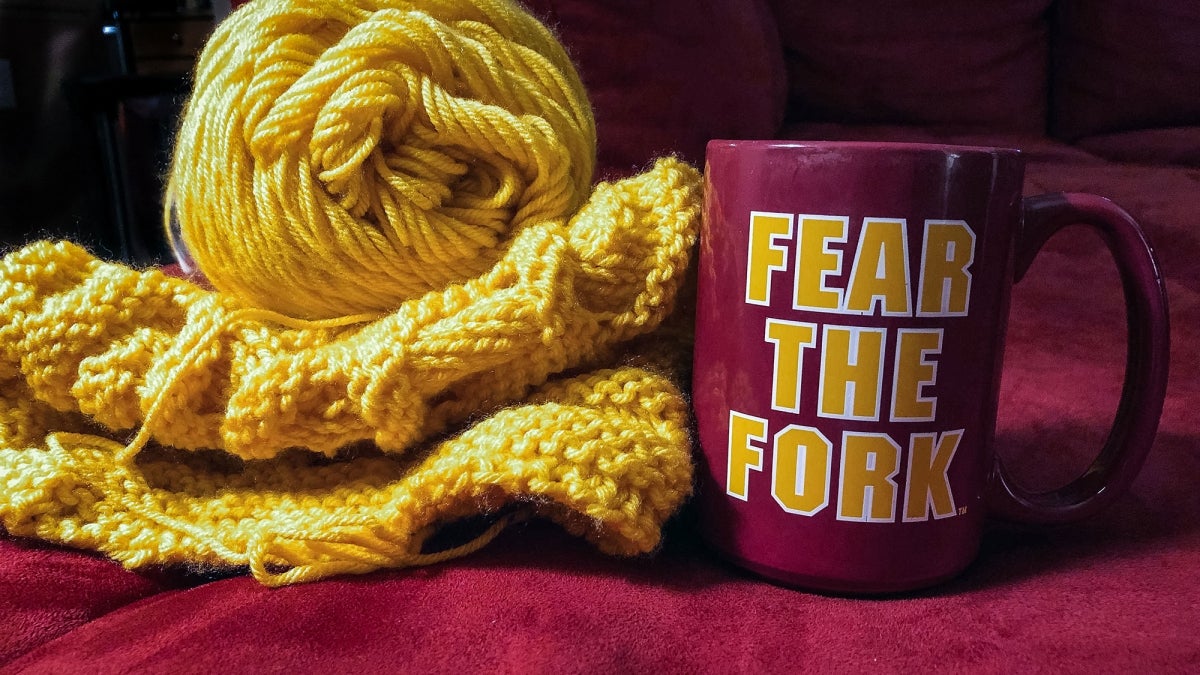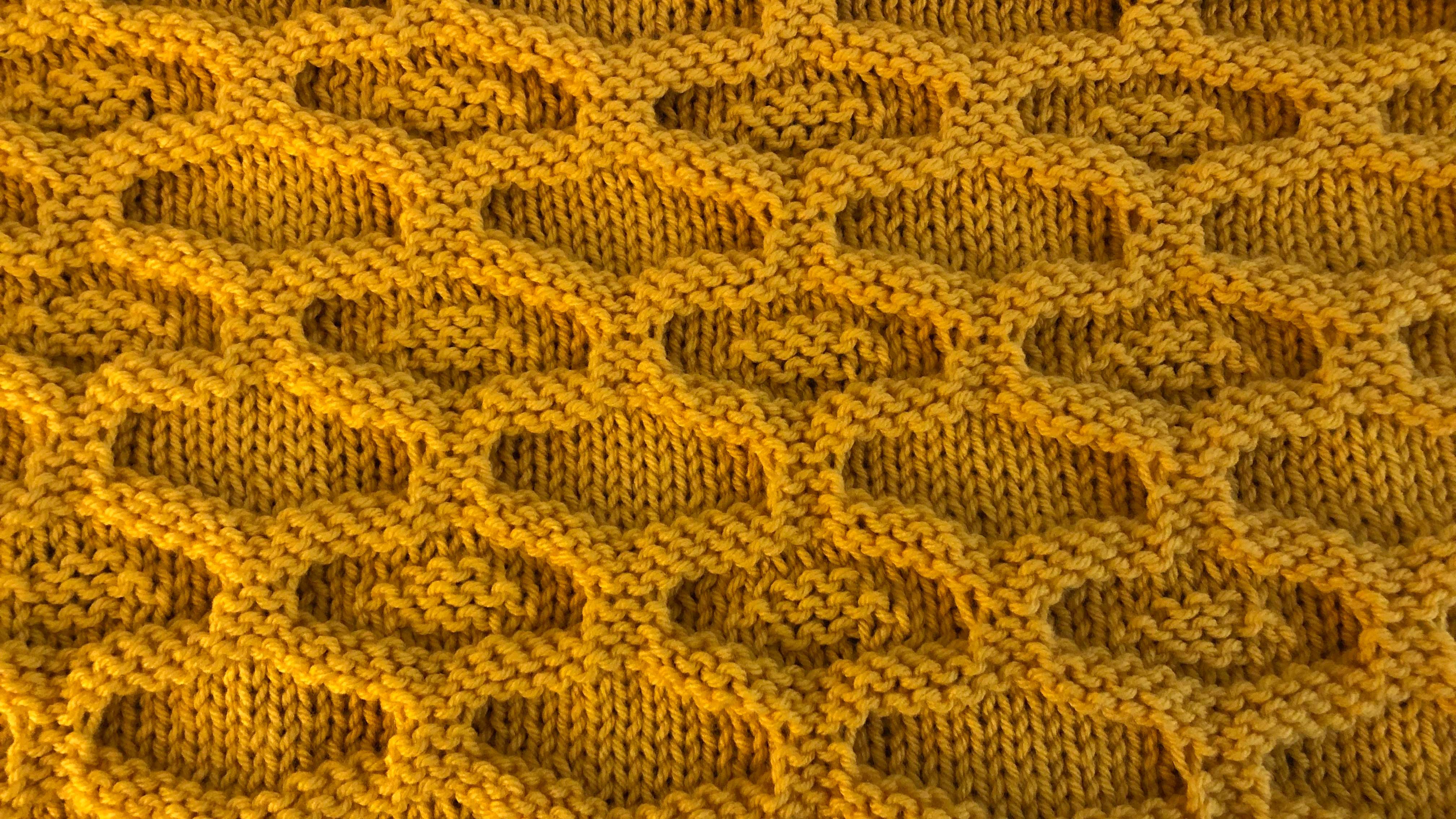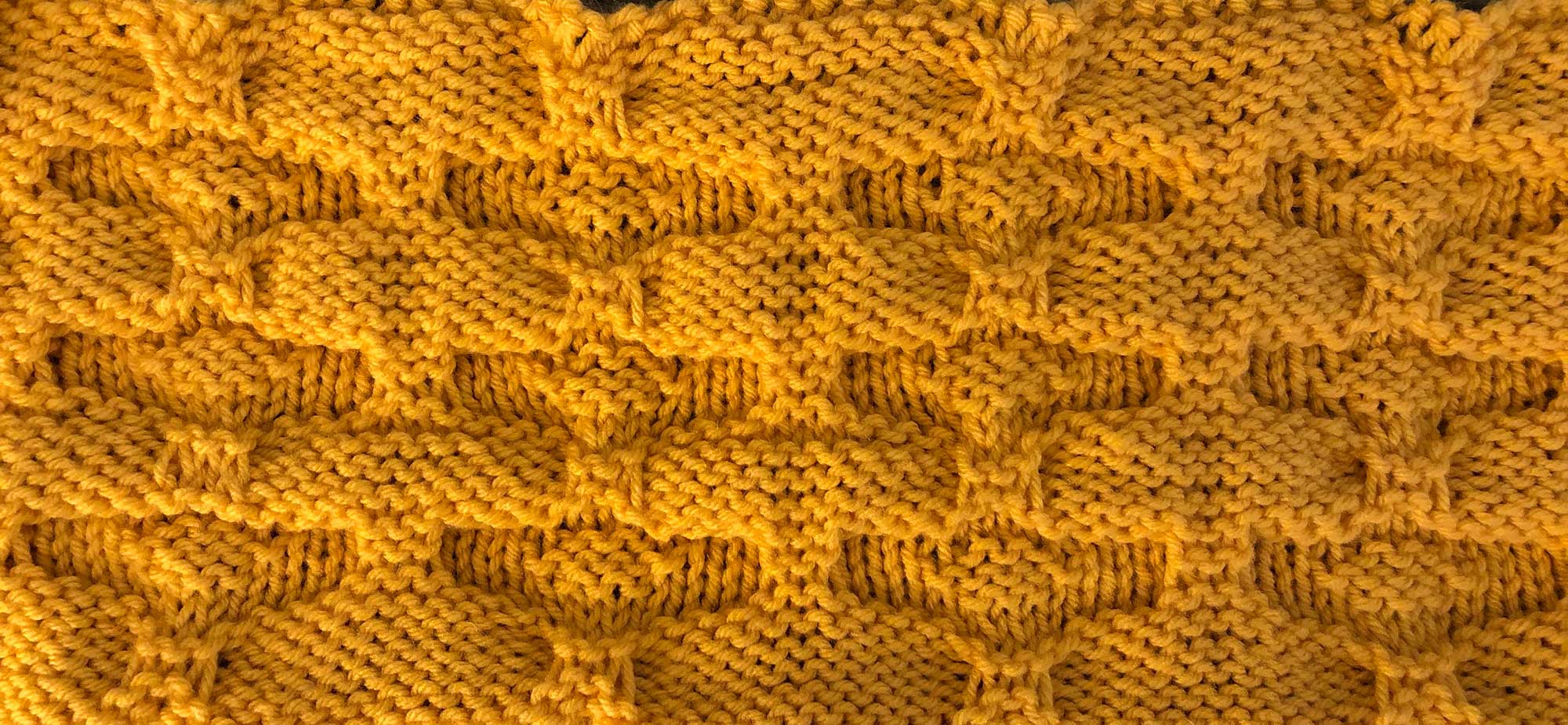Hayden Library, which reopened in January after a $90 million renovation, was scheduled to have its grand opening on March 25. Alas, as with so many events in the age of COVID-19, that celebration has been postponed.
But we can still pay tribute from our couches with a knitting pattern inspired by the midcentury panels on the library's exterior. There are two versions below — one more closely resembling (or attempting to resemble) the building and another that has fun with the honeycomb pattern (I prefer that one).

Look at those gorgeous midcentury panels on Hayden Library's exterior. Photo by Charlie Leight/ASU Now
A few thoughts:
• This pattern can easily adjust to whatever weight yarn you have on hand (I used Yarnspirations Caron in Sunflower, because it looked like ASU gold). If you need to purchase some, keep in mind that many craft stores are now offering free curbside pickup (please stay safe and keep your distance from anyone outside your household). But let's be honest: If you're able to understand the patterns below, you probably have five years' worth of yarn stashed away at home.
• If you've always wanted to learn to knit, YouTube can be a great teacher. There are bushels of yarn teachers on that website; find one whose style fits you. And don't forget about that relative of yours who knits or crochets; now would be a great time to FaceTime or Skype with him or her, learn some skills and bond with far-away family.
• The patterns below have not been test-knitted by anyone, so if you spot an issue, please email me (contact info is at the bottom of this story).
• If you're anything like me, any stress you're holding in your body can translate to tighter stitches on your needle. And there's a fair bit to be stressed about these days. I went up one needle size than was called for on the yarn label and may have gotten away with going two sizes bigger.
Not a knitter? What other clever campus-inspired creations might you think up — a cake that looks like ASU Gammage, a mini Fletcher Library made out of gingerbread, a to-scale model of the Polytechnic campus' Aviation Building using Hot Wheels, a baking-soda volcano that bears a striking resemblance to "A" Mountain for your kid's remote-learning science fair ... Creativity can do a lot to distract from the day's stressful headlines.
One final word before we get to the patterns: If you find your mind distracted by the news of the day and you mess up a stitch, give yourself grace. Learning to undo stitches is as much a part of knitting as making the stitches in the first place. Take it slow, breathe deeply and be gentle on yourself and others. We're going to make it through.
Hayden version 1: Honeycomb variation (yay!)
Precise gauge isn't super important; just make sure the resulting fabric isn't too stiff. On my sample (medium/4 yarn, U.S. size 10 needles), each honeycomb section was 4 inches wide.
Work in multiples of 14 stitches plus 1 stitch, plus edge stitches (in this case, 8 edge stitches). So if you wanted five repeats of the pattern across your row, for example, you would cast on 79. Also, you don't have to use stitch markers, but they're awfully handy in alerting you you're at the edge stitches.
CO. Knit four rows. Start panel pattern.
Panel pattern:
Row 1: K4, place marker, purl to last 4 stitches, place marker, K4.
Row 2: K4, slip marker (sm), knit to stitch marker, sm, K4 (basically, just knit across the entire row).
Row 3: K4, sm, purl to second marker, sm, K4.
Row 4: K4, sm, P1, *P5, slip 3 purlwise (yarn in front), P6*, repeat from * to second stitch marker, sm, K4.
Row 5: K4, sm, *K6, slip 3 purlwise (yarn in back), K5*, repeat from * to last stitch before second stitch marker, K1, sm, K4.
Row 6: same as row 4.
Row 7: same as row 5.
Row 8: same as row 4.
Row 9: same as row 5.
Row 10: same as row 4.
Row 11: K4, sm, purl to second marker, sm, K4.
Row 12: K4, sm, knit to stitch marker, sm, K4.
Row 13: K4, sm, purl to second marker, sm, K4.
Row 14: K4, sm, slip 1 purlwise (yarn in front), *slip 1 purlwise (yarn in front), P11, slip 2 purlwise (yarn in front)*, repeat from * to second stitch marker, sm, K4.
Row 15: K4, sm, *slip 2 purlwise (yarn at back), K11, slip 1 purlwise (yarn at back)*, repeat from * to last stitch before second stitch marker, slip 1 purlwise (yarn at back), sm, K4.
Row 16: K4, sm, slip 1 purlwise (yarn in front), *slip 1 purlwise (yarn in front), P4 K3 P4, slip 2 purlwise (yarn in front)*, repeat from * to second stitch marker, sm, K4.
Row 17: K4, sm, *slip 2 purlwise (yarn at back), K3 P5 K3, slip 1 purlwise (yarn at back)*, repeat from * to last stitch before second stitch marker, slip 1 purlwise (yarn at back), sm, K4.
Row 18: same as row 16.
Row 19: same as row 15.
Row 20: same as row 14.
Repeat panel pattern until desired length is reached; end after a row 13. Then knit four rows and bind off.
Hayden version 2: Trying to mimic the building (slightly less successful)
Precise gauge isn't super important; just make sure the resulting fabric isn't too stiff. On my sample (medium/4 yarn, U.S. size 10 needles), each honeycomb section was roughly 4 inches wide.
Work in multiples of 14 stitches plus 1 stitch, plus edge stitches (in this case, 8 edge stitches). So if you wanted five repeats of the pattern across your row, for example, you would cast on 79. Also, you don't have to use stitch markers, but they're awfully handy in alerting you you're at the edge stitches.
CO. Knit four rows. Start panel pattern.
Panel pattern:
Row 1: K4, place marker, purl to last 4 stitches, place marker, K4.
Row 2: K4, slip marker (sm), K1, *K5, slip 3 purlwise (yarn in front), K6*, repeat from * to second stitch marker, sm, K4. (NOTE on rows 2-4 on this version: When it's time to slip the stitches, you'll have to move the working yarn from back to front or vice versa. Everywhere else in these two patterns, when it's time to slip stitches, your yarn will naturally be on the correct side.)
Row 3: K4, sm, *P6, slip 3 purlwise (yarn in back), P5*, repeat from * to last stitch before second stitch marker, P1, sm, K4.
Row 4: same as row 2.
Row 5: same as row 3.
Row 6: same as row 2.
Row 7: same as row 1.
Row 8: K4, sm, slip 1 purlwise (yarn in front), *slip 1 purlwise (yarn in front), P11, slip 2 purlwise (yarn in front)*, repeat from * to second stitch marker, sm, K4.
Row 9: K4, sm, *slip 2 purlwise (yarn at back), K11, slip 1 purlwise (yarn at back)*, repeat from * to last stitch before second stitch marker, slip 1 purlwise (yarn at back), sm, K4.
Row 10: K4, sm, slip 1 purlwise (yarn in front), *slip 1 purlwise (yarn in front), P4 K3 P4, slip 2 purlwise (yarn in front)*, repeat from * to second stitch marker, sm, K4.
Row 11: K4, sm, *slip 2 purlwise (yarn at back), K3 P5 K3, slip 1 purlwise (yarn at back)*, repeat from * to last stitch before second stitch marker, slip 1 purlwise (yarn at back), sm, K4.
Row 12: same as row 10.
Row 13: same as row 9.
Row 14: same as row 8.
Repeat panel pattern until desired length is reached; end after a row 7. Then knit four rows and bind off.
Thanks to "400 Knitting Stitches" from Potter Craft for the "Raised Paving 2" pattern that inspired these.
More Arts, humanities and education

ASU instructor’s debut novel becomes a bestseller on Amazon
Desiree Prieto Groft’s newly released novel "Girl, Unemployed" focuses on women and work — a subject close to Groft’s heart.“I have always been obsessed with women and jobs,” said Groft, a writing…

‘It all started at ASU’: Football player, theater alum makes the big screen
For filmmaker Ben Fritz, everything is about connection, relationships and overcoming expectations. “It’s about seeing people beyond how they see themselves,” he said. “When you create a space…

Lost languages mean lost cultures
By Alyssa Arns and Kristen LaRue-SandlerWhat if your language disappeared?Over the span of human existence, civilizations have come and gone. For many, the absence of written records means we know…




